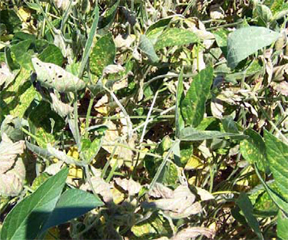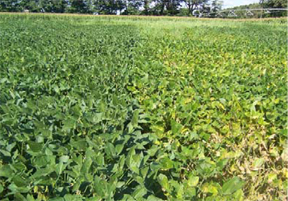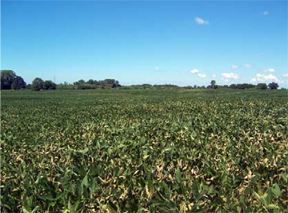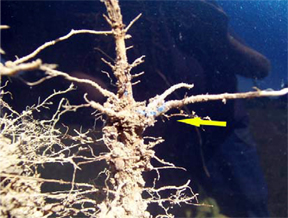Soybean Sudden Death Syndrome seen in an alarming number of soybean fields in Southwest Michigan
Editor’s note: This article is from the archives of the MSUCrop Advisory Team Alerts. Check the label of any pesticide referenced to ensure your use is included.
Symptoms of soybean Sudden Death Syndrome have been popping up in a lot of soybean fields in southwest and south central Michigan, especially in southern Berrien, St. Joseph and Calhoun counties. Growers should be on the lookout for areas of the field that are exhibiting yellow and brown colored leaves in the upper plant canopy that appear to be prematurely drying down in fields. On closer inspection, plants will exhibit yellowing areas in the upper canopy, with severe symptoms showing browning tissue between the leaf veins. Initial symptoms may appear as yellowish spots on the leaves. Highly infected plants will show excessive yellowing or premature leaf drop and relatively sudden plant death. The primary damage from this disease is premature or aborted pod fill, which robs yields by preventing soybeans from sizing properly. How much yield loss occurs depends on how severely and how early the symptoms begin to develop in the field. In some fields, the disease may be appearing more in areas where compaction or early season standing water may have been an issue, especially along headlands of fields. In other fields, the symptoms seem to appear in pockets, more along the lines of what we see in soybean cyst nematode (SCN) infestations. Incidence of SDS has been closely linked to SCN. It may be a good idea to pull soil samples from the area of soybean root masses this fall if you have areas heavily affected by the SDS disease.
If you see signs of SDS in your fields there is not anything you can do to treat the infection this season. However, it is important to note both how widespread and severe the infection is so that you can make management decisions in future years. At this time, the two most important management tools you can use to reduce the impact of SDS in the future are:
- Plant the most SDS resistant soybean varieties you can find in these fields.
- Prevent soil movement from areas with known infection by pressure washing equipment between farms and between infected and non-infected fields.
- Follow your rotation plan. Unfortunately, the limited research available shows that the pathogen can survive in the soil on residue, and rotation has not markedly reduced levels of SDS in fields in subsequent years.
There appears to be a great deal of variation between soybean varieties in their ability to tolerate SDS in highly infected fields. Our research this summer at a field site near Decatur has shown huge differences in symptoms, growth and yield potential between soybean varieties. Seed companies have been making significant efforts to screen for SDS resistance/tolerance in their breeding programs. They should have ratings for SDS resistance for the soybean varieties for 2011. You will probably have to ask them to provide a comprehensive rating comparison of their varieties for SDS, but they should be able to make one available.
This is one of the few times that a large scale scouting operation can be completed through a windshield at fairly normal speeds, so it will not take a lot of effort to look over fields in a short amount of time. This scouting however, must be completed fairly soon to distinguish SDS from areas naturally starting to turn color though the maturation process as early planted soybeans approach physiological maturity.
There is one caveat for this method of scouting. Not all yellowed pockets of soybeans in fields are caused by SDS. It is a good initial screening tool, but not the definitive answer. In driving a transect in Berrien County on August 18, there were plenty of other causes for yellowed soybeans, including manganese deficiency, potassium deficiency, spider mite damage and the lingering impacts of wet spots in fields. Be sure to look for the distinct yellow and brown pattern on the upper leaves. Even then, a disease called brown stem rot can create similar patterns on the leaves, but will exhibit a browning of the pith in the stem above the roots if the stems are split. SDS does not cause stem pith to turn brown. Also, if you dig the roots out and gently remove the soil from around the root mass, SDS infected plants are showing blue to gray colored fungal growth in flecks on the root surface, which is fairly evident this season (see yellow arrow on picture).
MSU and the Michigan Soybean Promotion Committee are hosting a field day at the Decatur SDS Research Plots on August 31 from 10:30 AM until around noon. You are welcome to attend if you would like to see how a severely infected SDS site impacts soybean yields on resistant and susceptible varieties. Speakers will include Dr. George Bird, MSU Field Crops Nematologist, Dr. Dechen Wang, MSU Soybean Breeder, Dr. Martin Chilvers, MSU Department of Plant Pathology and Keith Reinholt of the Michigan Soybean Promotion Committee. Light refreshments will be provided. The research site is located about ¼ of a mile east of 50th street on County Road 352, about 3 miles west of Decatur.
You can access more information on SDS from the MSU Department of Plant Pathology from this Field CAT Alert article posted July 29, 2010.
Also from Soybean Growers Support web site: http://www.planthealth.info/sds_basics.htm



 Print
Print Email
Email






